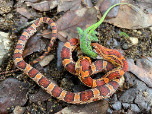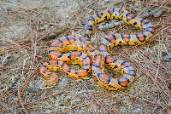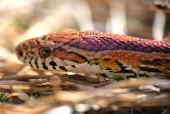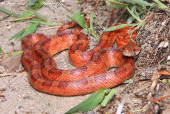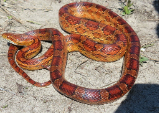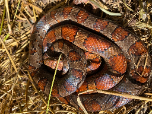|
Corn Snake (Pantherophis guttatus)
Description: As an adult the corn snake may have a total length (including tail) of 2.00–5.97 feet. In the wild, it usually lives around ten to fifteen years, but in captivity can live to an age of 23 years or more. The record for the oldest corn snake in captivity was 32 years and 3 months. The natural corn snake is usually orange or brown bodied with large red blotches outlined in black down their backs. The belly has distinctive rows of alternating black and white marks. This black and white checker pattern is similar to Indian corn which is where the name corn snake may have come from. The corn snake can be distinguished from a copperhead by the corn snake's brighter colors, slender build, slim head, round pupils, and lack of heat-sensing pits.
Habitat: In the wild, the corn snake prefers habitats such as overgrown fields, forest openings, trees, palmetto flatwoods, and abandoned or seldom-used buildings and farms, from sea level to as high as 6,000 feet. Typically, the corn snake remains on the ground until the age of four months but can ascend trees, cliffs, and other elevated surfaces.
In colder regions, the corn snake brumates during winter. However, in the more temperate climate along the coast, it shelters in rock crevices and logs during cold weather. It also can find shelter in small, closed spaces, such as under a house, and come out on warm days to soak up the heat of the sun. During cold weather, the corn snake is less active so it hunts less.
Range: It can be found in the Southeastern United States ranging from New Jersey to the Florida Keys.
Diet: Like all snakes, corn snakes are carnivorous and, in the wild, they eat every few days. While most corn snakes eat small rodents, such as the white-footed mouse, they may also eat other reptiles, or amphibians, or climb trees to find unguarded bird eggs.
Reproduction: orn snakes usually breed shortly after the winter cooling. The male courts the female primarily with tactile and chemical cues, then everts one of his hemipenes, inserts it into the female, and ejaculates his sperm. If the female is ovulating, the eggs will be fertilized and she will begin sequestering nutrients into the eggs, then secreting a shell.
Egg-laying occurs slightly more than a month after mating, with 12–24 eggs deposited into a warm, moist, hidden location. Once laid, the adult snake abandons the eggs and does not return to them. The eggs are oblong with leathery, flexible shells. About 10 weeks after laying, the young snakes use a specialized scale called an egg tooth to slice slits in the egg shell, from which they emerge at about 5 inches long.
Status: Listed as Least Concern in view of the large extent of occurrence, area of occupancy, number of subpopulations, and population size, and because the species probably is not declining.
Taxonomy: Until 2002, the corn snake was considered to have two subspecies: the nominate subspecies (P. g. guttatus) described here and the Great Plains rat snake (P. g. emoryi). The latter has since been split off as its own species (P. emoryi), but is still occasionally treated as a subspecies of the corn snake by hobbyists.
»» Kingdom: Animalia - Animals
»» Phylum: Chordata - Chordates
»» Subphylum: Vertebrata - Vertebrates
»» Class: Reptilia - Reptiles
»» Order: Squamata - Scaled Reptiles
»» Suborder: Serpentes
»» Superfamily: Colubroidea
»» Family: Colubridae - Colubrids
»» Genus: Pantherophis
»» Species: Pantherophis guttatus - Corn Snake
This article uses material from the Wikipedia article "Corn Snake", which is released under the Creative Commons Attribution-Share-Alike License 3.0. Content may have been omitted from the original, but no content has been changed or extended.
|
|


